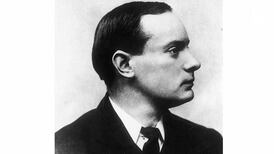Readers of a certain age will remember the singing voice of Bridie Gallagher, with its characteristic tone and warm Donegal lilt. Possibly Ireland’s first international pop star, or certainly one of its earliest, she will always be associated with traditional Irish ballads particularly beloved of Irish exiles. She was born 100 years ago on September 7th.
Bridget (always known as Bridie) Gallagher was the second youngest of 10 children of Jim Gallagher and Biddy Sweeney and was raised on a substantial farm near Creeslough, Co Donegal.
Following attendance at a local national school, she was offered a boarding scholarship at Loreto, Letterkenny, but her parents didn’t allow her to take it up and she left school at 14 to work in the local post office.
Coming from a musical family and gifted with a good ear and fine voice, she began performing at local concerts and events, soon joining a local dance band as lead singer and then moving on to a more professional outfit covering a wider area.
The Derry man who influenced George Washington and Alexander Hamilton - Brian Maye on Hercules Mulligan
The BBC’s national question: Frank McNally on Edna O’Brien and ‘the North of Ireland’
Dictionary on the Double – Frank McNally on the enduring literary life of Patrick Dinneen
‘This wonderful horse seems to have been as remarkable in death as in life’ – Frank McNally on an unbeatable stallion
She moved to Belfast in 1948 to work as a housekeeper and there met Robert Livingstone, a Protestant mechanic, whom she married in September 1951. Performing at variety concerts in Belfast, she was picked up by a local agency and in March 1953 released A Mother’s Love Is a Blessing on Decca Records, which sold well and led to further bookings.
Her normal repertoire at first was songs from the musicals or by Vera Lynn, but an astute music critic advised her to stick to Irish numbers. Her hand was forced to some extent when, at a major concert in Derry, other previous performers having used much of the material she herself planned to sing, she relied instead on old songs learned in Creeslough, many of them from her mother. So well were they received, that it “changed the focus of her career”, according to Linde Lunney, who wrote the entry on her in the Dictionary of Irish Biography.
She toured as a support to Scottish star Kenneth McKellar for six weeks in 1957 and packed the London Palladium in January 1959 with an audience of mainly Irish exiles in the city. “Her voice, with its characteristic ‘break’ and timbre, her natural and relaxed stage manner, and her homely repertoire had widespread appeal,” according to Linde Lunney.
Emigrants found her songs about Ireland deeply moving and over time she developed a repertoire that had one song from each Irish county. Two songs she became particularly associated with were The Boys from the County Armagh and The Homes of Donegal. Because of her close connection to her native county, she became known as the “Girl from Donegal”.
Displaying a high level of professionalism as a performer, she also showed good business acumen in running a showbusiness agency in Belfast with her husband for many years and putting on summer shows in Bundoran and other resorts in which she employed her own musicians and supporting acts. She drew enormous audiences to her concerts. It’s been claimed that she holds the record for the largest attendance at London’s Albert Hall, with more than 7,500 present – as the venue became all seater, the record was never equalled. She toured Britain annually, and the US, Canada and Australia regularly, selling out many venues on her tours.
She recorded on several record labels, with 11 solo albums and songs on numerous compilation albums. Many of her 32 singles did well in the charts. The long history of Irish emigration throughout her career provided her with guaranteed – if ageing – audiences abroad and she showed adaptability at home as entertainment trends changed. As concerts and variety shows gave way to the showband era, for some 20 years she travelled Ireland with such bands as the Royal and the Clipper Carlton and then did the cabaret circuit.
Her husband became a Catholic to marry her but neither family was happy with the union. It worked for a time and they had two sons but eventually separation, though not divorce, occurred, the separation never being made public. Tragedy struck when the younger son, Peter, was killed in a motorcycle accident in 1976 at 21. A period of deep depression and heavy drinking followed but with family and fan support, she resumed her career and won a lifetime achievement award in 1991. Although she made many TV appearances, she was disappointed that RTÉ didn’t enable her to front her own programme, according to Linde Lunney.
She might have believed herself forgotten by the turn of the millennium but in July 2000, a plaque was unveiled at her birthplace in Creeslough and she was given a civic reception by Donegal County Council. Living most of her life in Belfast, she died in hospital there on January 9th, 2012, and was buried in Doe Cemetery, Creeslough, following a huge funeral. Numerous tributes acknowledged her trailblazing status in Irish popular music. Her surviving son, Jim Livingstone, published a biography of his mother in 2015.













